Experimental Study and Numerical Analysis of Chloride Ion Diffusion in Hydrotalcite Concrete in Chloride Salt Environment
Abstract
:1. Introduction
2. Materials and Methods
2.1. Materials and Specimen Preparation
2.2. Hydrotalcite Chloride Ion Fixation Test
2.3. Compressive Strength Test
2.4. One Dimensional Accelerated Chloride Penetration Test
2.5. Chloride Ion Concentration Measurement
2.6. Microscopic Test
2.7. Statistical Method of Parameter Calculation
2.7.1. Fick’s Second Law
2.7.2. Time Decay Coefficient
2.7.3. Concrete Deterioration Factor
2.7.4. Chloride Ion-Binding Capacity
2.7.5. Internal Relative Humidity Influence Factor
2.7.6. Temperature Parameters
2.7.7. Multi-Factor Chloride Ions Diffusion Model
3. Test Results
3.1. Compressive Strength of Hydrotalcite Concrete
3.2. One-Dimensional Accelerated Chloride Penetration
3.3. Chloride Adsorption Mechanism of LDOs
3.3.1. XRD
3.3.2. SEM
4. Numerical Simulation
4.1. Module Selection
4.2. Parameter Setting
4.3. Analysis of Numerical Simulation Results
4.3.1. Effect of Erosion Age on the Distribution of Chloride Ion Concentration
4.3.2. Effect of LDOs Dosages on the Distribution of Chloride Ion Concentration
4.3.3. Comparison between COMSOL Numerical Solution and Experimental Data
5. Conclusions
- (1)
- The improvement of the compressive strength of concrete by incorporating hydrotalcite roasted at 500 °C was obvious. The compressive strength of hydrotalcite concrete increased first and then decreased with the increase in LDOs, and the optimal amount of LDHs was 2% wt. Its 28-day compressive strength was increased by 10.95% compared to the control group, meeting the requirement for design strength.
- (2)
- The one-dimensional accelerated chloride penetration test showed that the roasted LDOs have good chloride ion adsorption capacity; the chloride ion concentration increased firstly and then decreased with the increase in hydrotalcite dosages. In the chloride salt environment, chloride ions diffused from the surface to the interior of the concrete through the water, and the chloride ion concentration of the concrete in the REF group was much higher than that of the concrete mixed with hydrotalcite.
- (3)
- The mechanism of solidifying chloride ions in LDOs materials was investigated by means of XRD and SEM microscopic tests from two perspectives: physical phase composition and microscopic morphology. Compared with the LDHs material, the LDOs material treated by roasting at 500 °C appears to be a spinel material and does not possess the characteristic diffraction peaks of MgAl-CO3 LDHs. The LDOs material can complete the structural reconstruction by the adsorption of chloride ions after the hydration reaction in NaCl solution for 24 h, and its microscopic morphology is still obvious in the form of the lamellar structure.
- (4)
- The numerical simulation analysis by COMSOL shows that the simulation results of chloride ion concentration with diffusion depth are in good agreement with the experimental results, and the two conclusions are consistent. The amount of hydrotalcite has different effects on chloride ion diffusion, and according to the diffusion depth, it can be concluded that the anti-chloride ion permeation performance is in the following order: L2 group > L4 group > L6 group > REF group.
Author Contributions
Funding
Institutional Review Board Statement
Informed Consent Statement
Data Availability Statement
Acknowledgments
Conflicts of Interest
References
- Yang, C.H.; Yan, Y.; Ou, Z.W. Capacity of cement paste binding chloride ions with metakaolin as admixture. Concrete 2010, 10, 1–3+7. (In Chinese) [Google Scholar]
- Tang, S.W.; Yao, Y.; Andrade, C.; Li, Z.J. Recent durability studies on concrete structure. Cem. Concr. Res. 2015, 78, 143–154. [Google Scholar] [CrossRef]
- Otieno, O.; Beushausen, H.; Alexandre, M. Chloride-induced corrosion of steel in cracked concrete-Part I: Experimental studies under accelerated and natural marine environments. Cem. Concr. Res. 2016, 79, 373–385. [Google Scholar] [CrossRef]
- Xiong, C.; Li, W.; Jin, Z.; Gao, X.; Wang, W.; Tian, H.; Han, P.; Song, L.; Jiang, L. Preparation of phytic acid conversion coating and corrosion protection performances for steel in chlorinated simulated concrete pore solution. Corros. Sci. 2018, 139, 275–288. [Google Scholar] [CrossRef]
- Jin, Z.; Chang, H.; Du, F.; Zhao, T.; Jiang, Y.; Chen, Y. Influence of SAP on the chloride penetration and corrosion behavior of steel bar in concrete. Corros. Sci. 2020, 171, 108714. [Google Scholar] [CrossRef]
- Chen, C.; Jiang, L.; Guo, M.Z.; Xu, P.; Chen, L.; Zha, J. Effect of sulfate ions on corrosion of reinforced steel treated by DNA corrosion inhibitor in simulated concrete pore solution. Constr. Build. Mater. 2019, 228, 116752.1–116752.8. [Google Scholar] [CrossRef]
- Gomes, C.; Mir, Z.; Sampaio, R.S.; Bastos, A.; Maia, F.; Rocha, C.; Tedim, J.; Ferreira, M. Effect of layered double hydroxides on the performance and service life of reinforced concrete. In Proceedings of the Conference on Durable Concrete for Infrastructure under Severe Conditions—Smart Admixtures, Self-Responsiveness and Nanoadditions, Ghent, Belgium, 10–11 September 2019. [Google Scholar]
- Zuo, J.; Wu, B.; Luo, C.; Dong, B.; Xing, F. Preparation of MgAl layered double hydroxides intercalated with nitrite ions and corrosion protection of steel bars in simulated carbonated concrete pore solution. Corros. Sci. 2019, 152, 120–129. [Google Scholar] [CrossRef]
- Xu, J.; Song, Y.; Zhao, Y.; Jiang, L.; Mei, Y.; Chen, P. Chloride removal and corrosion inhibitions of nitrate, nitrite-intercalated Mg Al layered double hydroxides on steel in saturated calcium hydroxide solution. Appl. Clay Sci. 2018, 163, 129–136. [Google Scholar] [CrossRef]
- Chen, Y.; Shui, Z.; Chen, W.; Chen, G. Chloride binding of synthetic Ca–Al–NO3 LDHs in hardened cement paste—ScienceDirect. Constr. Build. Mater. 2015, 93, 1051–1058. [Google Scholar] [CrossRef]
- Tatematsu, H.; Sasaki, T. Repair materials system for chloride-induced corrosion of reinforcing bars. Cem. Concr. Compos. 2003, 25, 123–129. [Google Scholar] [CrossRef]
- Raki, L.; Beaudoin, J.J.; Mitchell, L. Layered double hydroxide-like materials: Nanocomposites for use in concrete. Cem. Concr. Res. 2004, 34, 1717–1724. [Google Scholar] [CrossRef]
- Hu, J.; Lv, L. Adsorption mechanism of chloride ions by calcined Mg-Al carbonate hydrotalcite. Chem. Eng. Equip. 2008, 4, 26–29. (In Chinese) [Google Scholar]
- Zhang, L. Synthesis of Mg-Al Layered Double Hydroxides and Their Adsorption Capability of Chloride Ion in Cement Paste. Ph.D. Thesis, University of South China, Hengyang, China, 2018. (In Chinese). [Google Scholar]
- Rajamallu, C.; Reddy, T.C.; Arunakanthi, E. Service life prediction of self-compacted concretes with respect to chloride ion penetration. Mater. Today: Proc. 2021, 46, 677–681. [Google Scholar] [CrossRef]
- Wang, P. Study on Salt Freezing Resistance of Calcined Hydrotalcite Cement-Based Composites. Bachelor’s Thesis, Chang’an University, Xi’an, China, 2020. (In Chinese). [Google Scholar]
- Duan, P.; Yan, C.; Chen, W.; Chen, G.; Shui, Z. Influence of layered double hydroxides on carbonation resistance of concrete. J. Chin. Ceram. Soc. 2014, 42, 1037–1041. [Google Scholar]
- Ma, J.; Duan, P.; Ren, D.; Zhou, W. Effects of layered double hydroxides incorporation on carbonation resistance of cementitious materials. J. Mater. Res. Technol. 2019, 8, 292–298. [Google Scholar] [CrossRef]
- Shui, Z.H.; Yu, R.; Chen, Y.X.; Duan, P.; Ma, J.T.; Wang, X.P. Improvement of concrete carbonation resistance based on a structure modified Layered Double Hydroxides (LDHs): Experiments and mechanism analysis. Constr. Build. Mater. 2018, 176, 228–240. [Google Scholar] [CrossRef]
- Liu, T.; Chen, Y.; Yu, Q.; Fan, J.; Brouwers, H.J.H. Effect of MgO, Mg-Al-NO3 LDH and calcined LDH-CO3 on chloride resistance of alkali activated fly ash and slag blends. Constr. Build. Mater. 2020, 250, 118865. [Google Scholar] [CrossRef]
- Liu, W.; Li, Y.; Tang, L.; Xing, F. Modelling analysis of chloride redistribution in sea-sand concrete exposed to atmospheric environment. Constr. Build. Mater. 2021, 274, 121962. [Google Scholar] [CrossRef]
- Wang, G.; Wu, Q.; Zhou, H.; Peng, C.; Chen, W. Diffusion of chloride ion in coral aggregate seawater concrete under marine environment. Constr. Build. Mater. 2021, 19, 122821. [Google Scholar] [CrossRef]
- Paul, S.K.; Chaudhuri, S.; Barai, S.V. Chloride diffusion study in different types of concrete using finite element method (FEM). Adv. Concr. Constr. 2014, 2, 39–56. [Google Scholar] [CrossRef]
- Chen, X.D.; Sun, L.F.; Cao, Z.F.; Zhu, X.J.; Zhao, L.X. Numerical simulation of chloride ion induced corrosion of reinforced concrete structures in marine environment. J. Chin. Soc. Corros. Prot. 2015, 35, 144–150. (In Chinese) [Google Scholar]
- Qiao, H.X.; Qiao, G.B.; Lu, C.G. Simulation and velocity analysis of chloride ion transport in concrete. J. Huazhong Univ. Sci. Technol. (Nat. Sci. Ed.) 2022, 50, 19–25. (In Chinese) [Google Scholar]
- JGJ55-2011; Chinese Specification for Mix Proportion Design of Ordinary Concrete. Ministry of Housing and Urban-Rural Development: Beijing, China, 2011.
- GB/T 50081-2019; Chinese Standard for Test Methods of Concrete Physical and Mechanical Properties. Standardization Administration of China: Beijing, China, 2019.
- GB/T8077-2012; Chinese Methods for Testing Uniformity of Concrete Admixture. Standardization Administration of China: Beijing, China, 2012.
- Yan, W.Y. Study of the Durability of UHPC Beams under Chloride Ion Erosion. Bachelor’s Thesis, Lanzhou Jiaotong University, Lanzhou, China, 2021. (In Chinese). [Google Scholar]
- Zhou, Q.; Lu, C.; Wang, W.; Wei, S.; Xi, B. Effect of fly ash and corrosion on bond behavior in reinforced concrete. Struct. Concr. 2020, 5, 1839–1852. [Google Scholar] [CrossRef]
- Thomas MD, A.; Bamforth, P.B. Modelling chloride diffusion in concrete -Effect of fly ash and slag. Cem. Concr. Res. 1999, 29, 487–495. [Google Scholar] [CrossRef]
- Wei, J.; Gui, Z.H.; Wang, Y.L. Modeling on predicting steel corrosion rate in concrete. J. Wuhan Univ. Technol. 2005, 27, 45–47. (In Chinese) [Google Scholar]
- Isteita, M.; Xi, Y. The effect of temperature variation on chloride penetration in concrete. Constr. Build. Mater. 2017, 156, 73–82. [Google Scholar] [CrossRef]
- Sergio, G.; Yu, S.W.; Page, C.L. Diffusion of chloride and hydroxyl ions in cementitious materials exposed a saline environment. Concr. Res. 1992, 44, 63–69. [Google Scholar] [CrossRef]
- Nilsson, L.O. Penetration of chlorides into concrete structures—An introduction and some definitions. In Nordic Miniseminar on Chloride Penetration into Concrete Structure; Nilsson, L.O., Ed.; Chalmers University of Technology: Goteborg, Sweden, 1993. [Google Scholar]
- Bazant, Z.P.; Najjar, L.J. Nonlinear water diffusion of non-saturated concrete. Mater. Constr. 1972, 5, 3–20. [Google Scholar] [CrossRef]
- Collepardi, M.; Marciallis, A.; Turriziani, R. Penetration of chloride ions in the cement paste and in concretes. J. Am. Ceram. Soc. 1972, 55, 534–535. [Google Scholar] [CrossRef]
- Liu, F. The Correction Model of Diffusion Theory about Chloride Ion in Concrete and Its Numerical Simulation. Bachelor’s Thesis, Anhui University of Science and Technology, Huainan, China, 2018. (In Chinese). [Google Scholar]
- Khan, A.; Irfan, M.; Niazi, U.M.; Shah, I.; Legutko, S.; Rahman, S.; Alwadie, A.S.; Jalalah, M.; Glowacz, A.; Khan, M.K.A. Centrifugal compressor stall control by the application of engineered surface roughness on diffuser shroud using numerical simulations. Materials 2021, 14, 2033. [Google Scholar] [CrossRef]

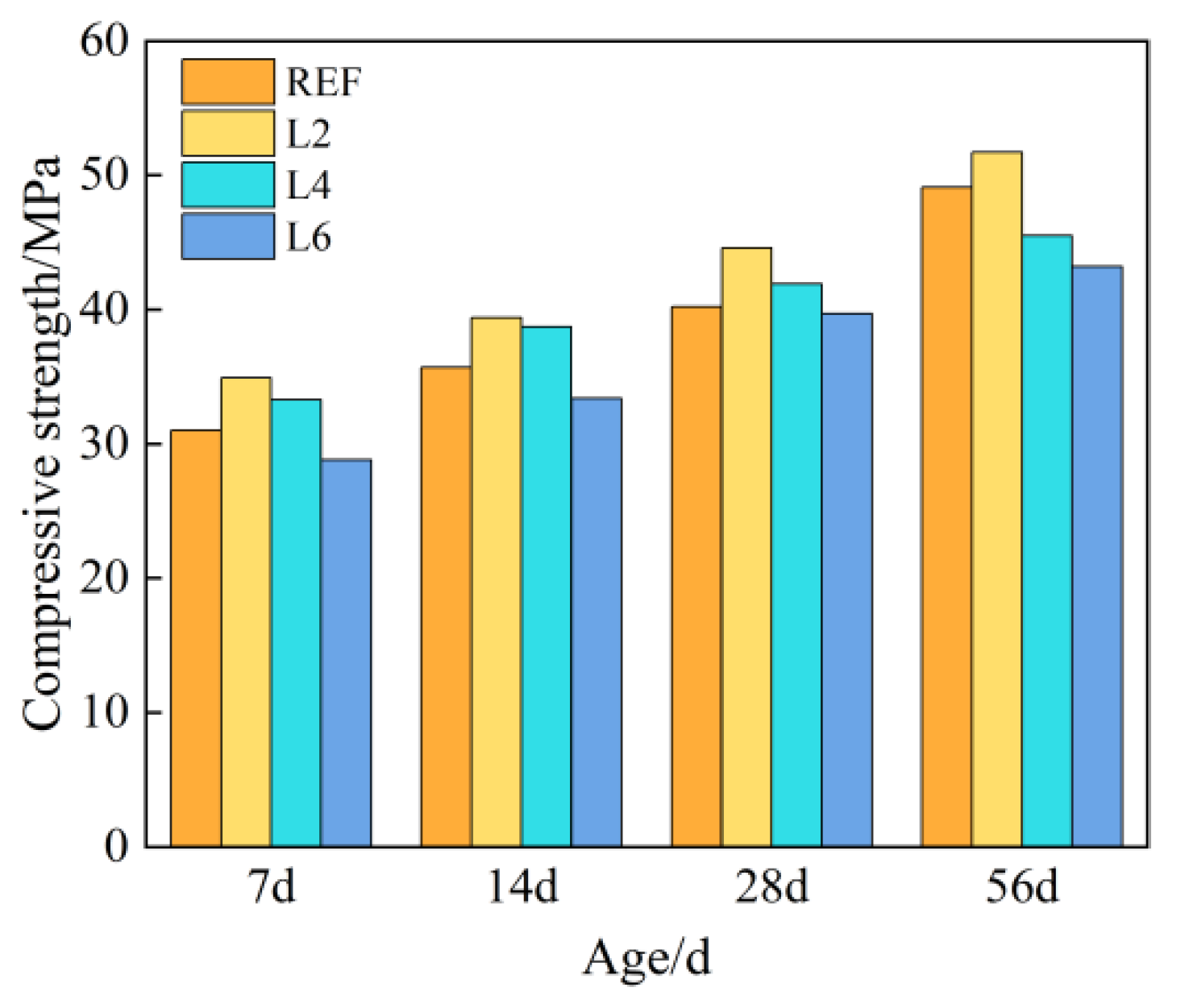

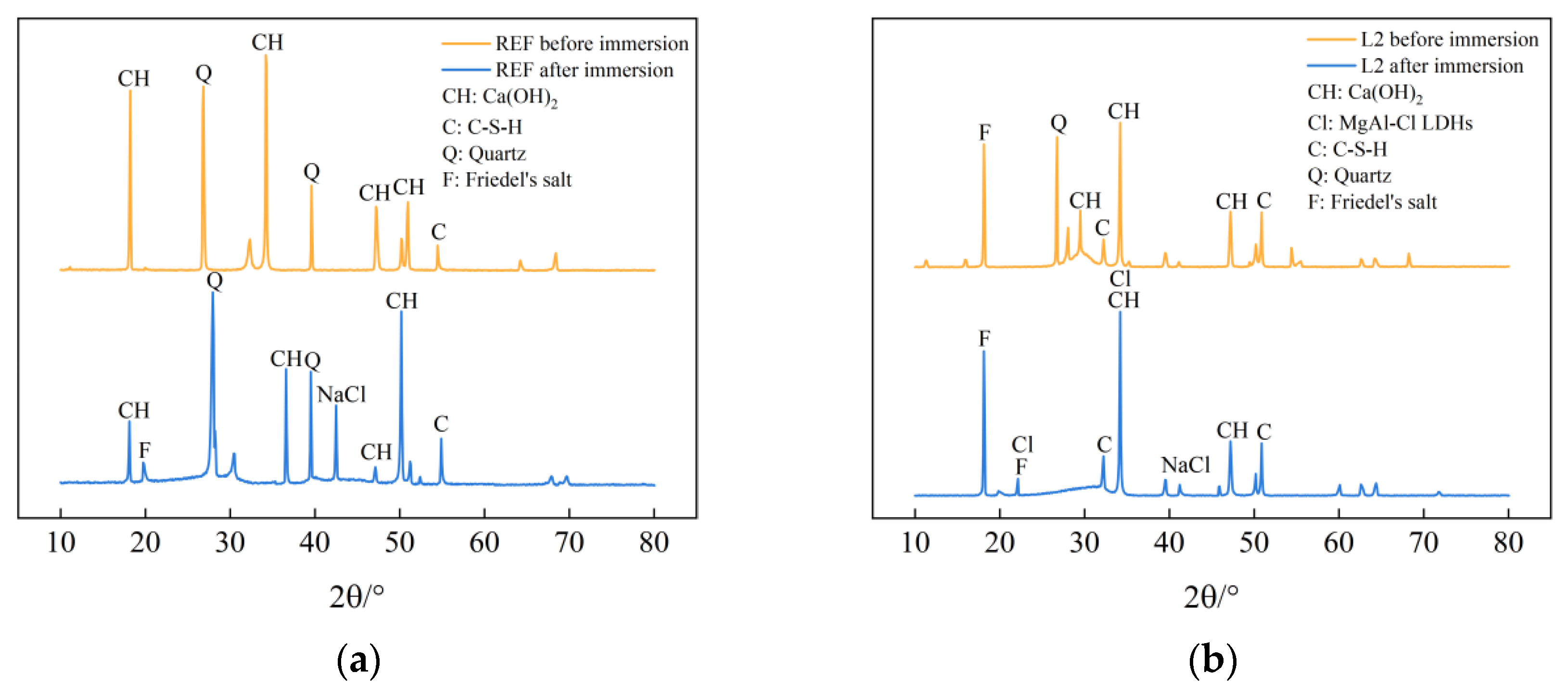
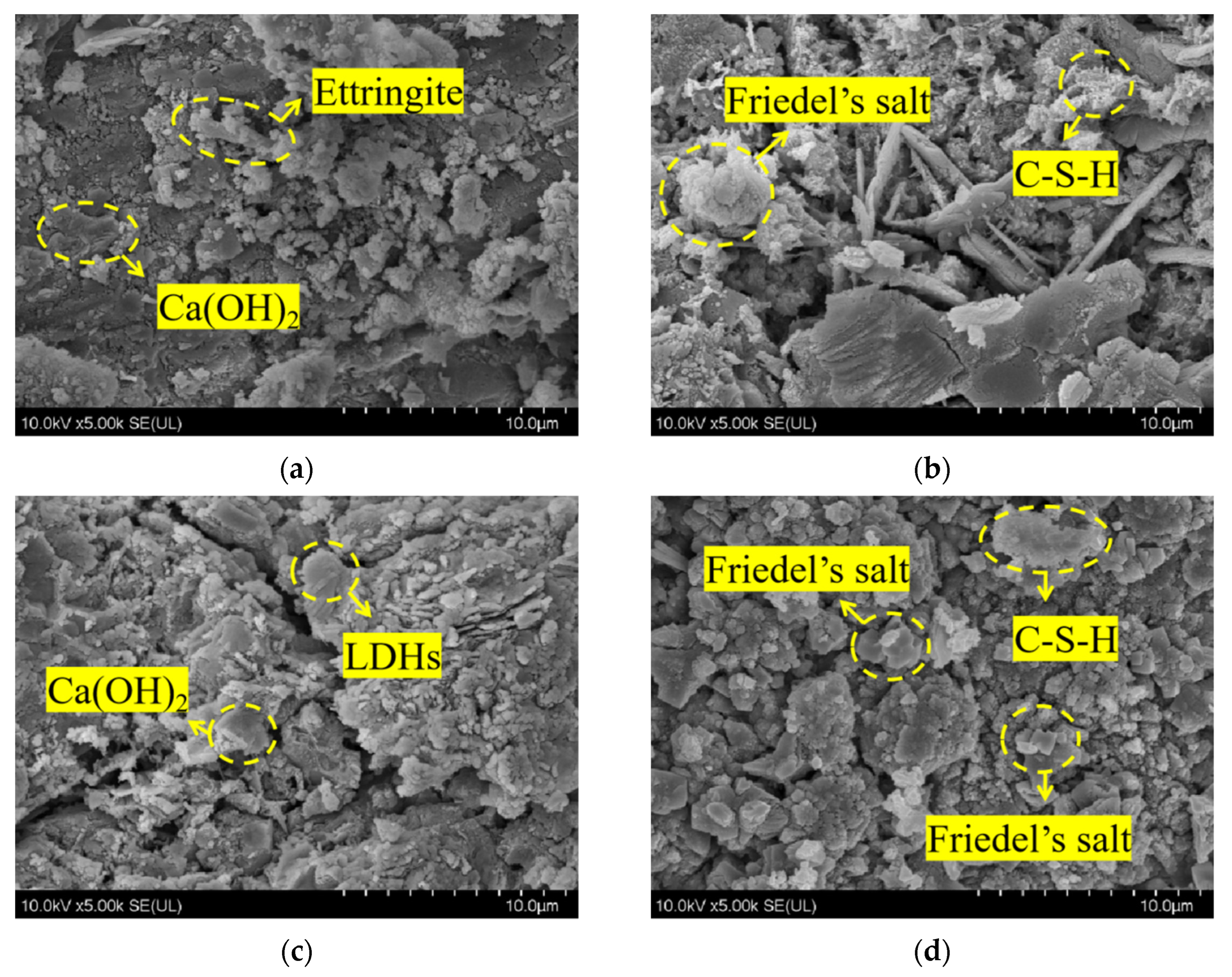
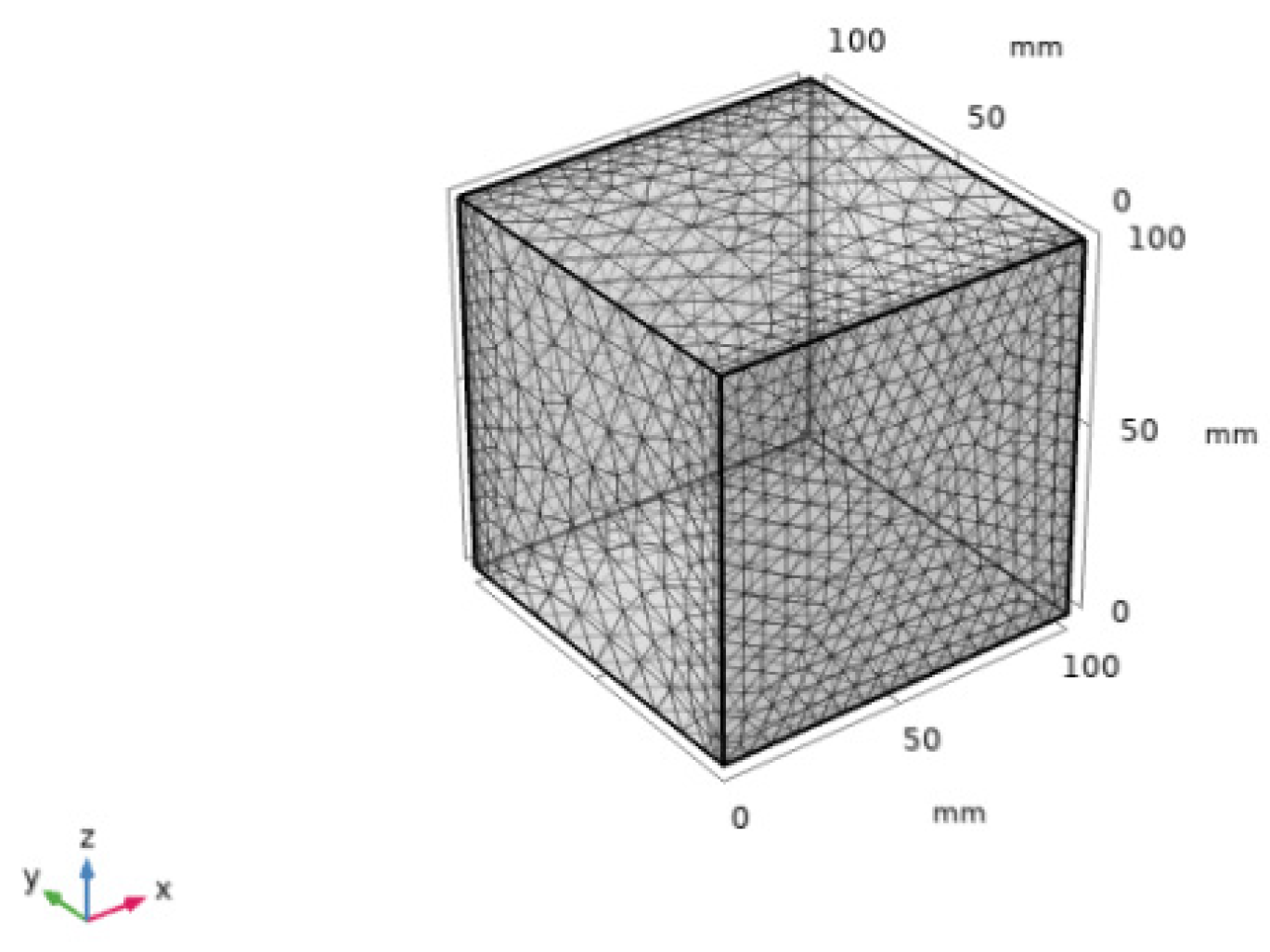

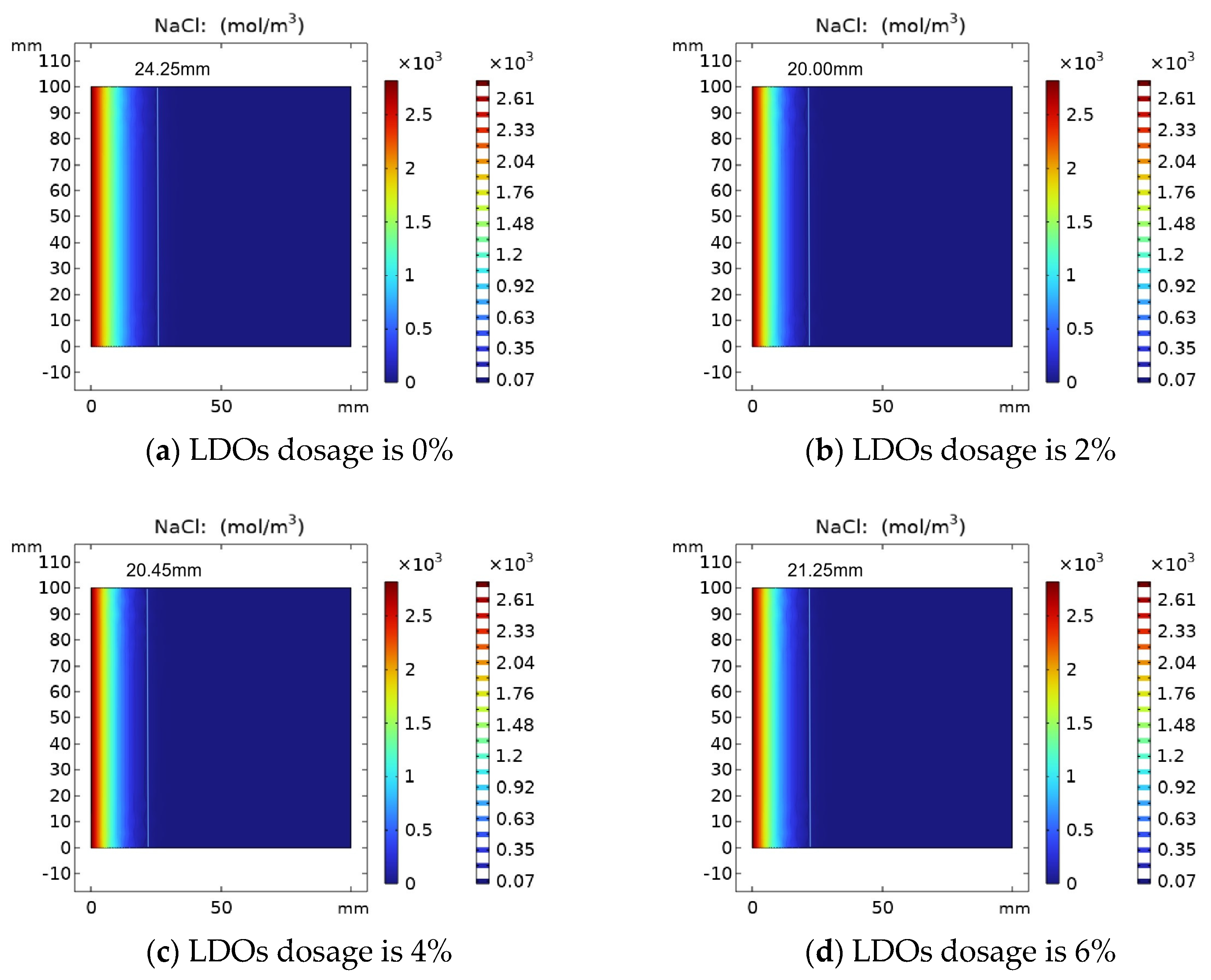
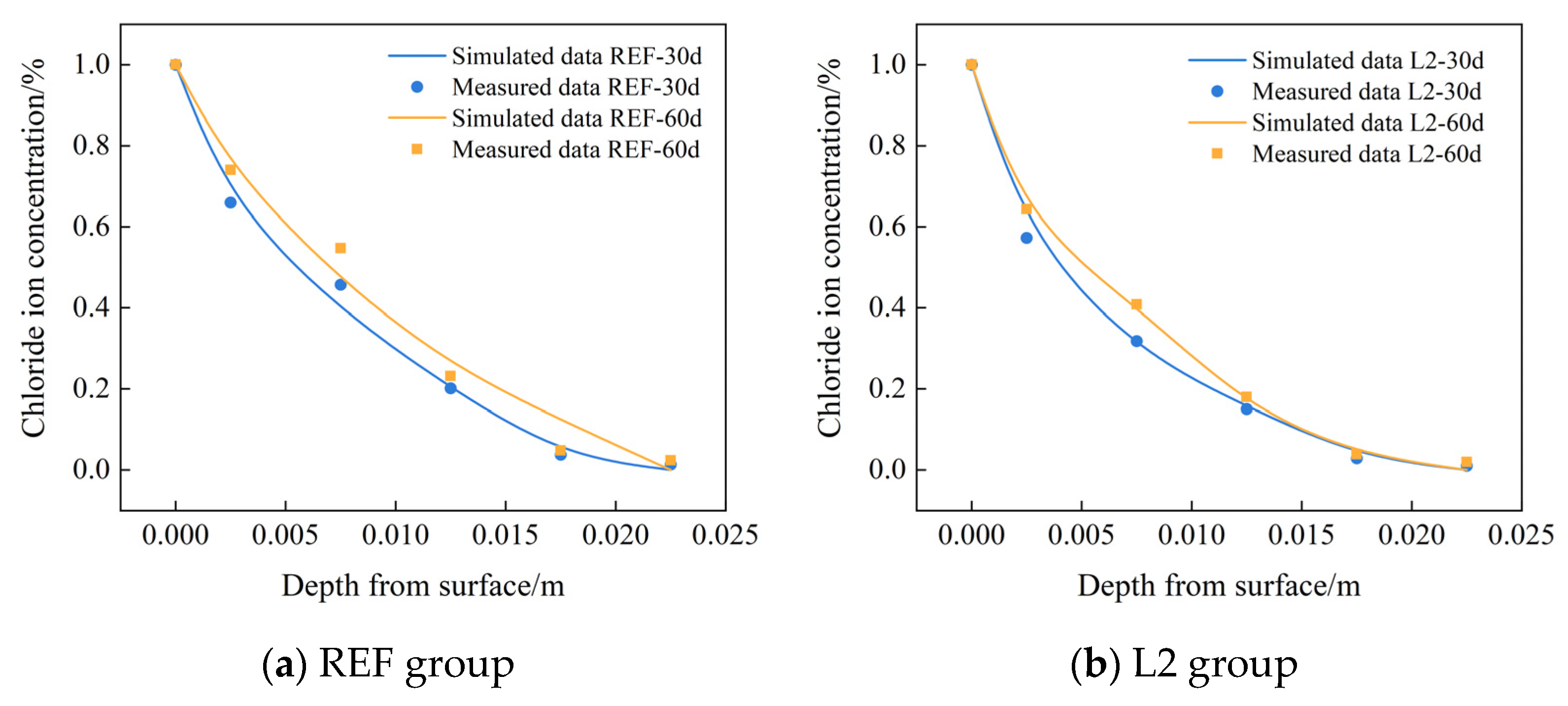
| Chemical Composition | SiO2 | Al2O3 | Fe2O3 | CaO | MgO | SO3 | LOI |
|---|---|---|---|---|---|---|---|
| LDHs | 3.26 | 44.63 | 0.23 | 0.40 | 50.06 | 1.28 | 0.32 |
| Cement | 23.92 | 4.65 | 3.99 | 61.71 | 2.18 | 3.68 | 0.98 |
| No. | Kg/m3 | Compressive Strength (MPa) | 30-Day Chloride Ion Permeability Coefficient (×10−13 m2/s) | |||||
|---|---|---|---|---|---|---|---|---|
| Cement | LDOs | Sand | Aggregate | Water | 7 d | 28 d | ||
| REF | 346.00 | 0 | 759 | 1138 | 156 | 31.2 | 40.2 | 7.35 |
| L2 | 339.08 | 6.92 | 759 | 1138 | 156 | 34.8 | 44.9 | 5.91 |
| L4 | 332.16 | 13.84 | 759 | 1138 | 156 | 33.9 | 43.0 | 7.20 |
| L6 | 325.24 | 20.76 | 759 | 1138 | 156 | 28.8 | 39.8 | 8.88 |
| Immersion Age/d | Specimen Number | Chloride Ion Diffusion Coefficient/×10−13 m2/s | Surface Chloride Ion Concentration/% | Correlation Coefficient |
|---|---|---|---|---|
| 30 | REF | 7.35 | 0.67 | 0.99 |
| L2 | 5.91 | 0.57 | 0.98 | |
| L4 | 7.20 | 0.58 | 0.97 | |
| L6 | 8.88 | 0.62 | 0.97 | |
| 60 | REF | 4.33 | 0.76 | 0.99 |
| L2 | 3.13 | 0.65 | 0.99 | |
| L4 | 3.49 | 0.69 | 0.98 | |
| L6 | 3.55 | 0.70 | 0.98 |
Disclaimer/Publisher’s Note: The statements, opinions and data contained in all publications are solely those of the individual author(s) and contributor(s) and not of MDPI and/or the editor(s). MDPI and/or the editor(s) disclaim responsibility for any injury to people or property resulting from any ideas, methods, instructions or products referred to in the content. |
© 2023 by the authors. Licensee MDPI, Basel, Switzerland. This article is an open access article distributed under the terms and conditions of the Creative Commons Attribution (CC BY) license (https://creativecommons.org/licenses/by/4.0/).
Share and Cite
Zhou, L.; Cai, Y.; Ma, C. Experimental Study and Numerical Analysis of Chloride Ion Diffusion in Hydrotalcite Concrete in Chloride Salt Environment. Materials 2023, 16, 6349. https://doi.org/10.3390/ma16196349
Zhou L, Cai Y, Ma C. Experimental Study and Numerical Analysis of Chloride Ion Diffusion in Hydrotalcite Concrete in Chloride Salt Environment. Materials. 2023; 16(19):6349. https://doi.org/10.3390/ma16196349
Chicago/Turabian StyleZhou, Lina, Ying Cai, and Cailong Ma. 2023. "Experimental Study and Numerical Analysis of Chloride Ion Diffusion in Hydrotalcite Concrete in Chloride Salt Environment" Materials 16, no. 19: 6349. https://doi.org/10.3390/ma16196349
APA StyleZhou, L., Cai, Y., & Ma, C. (2023). Experimental Study and Numerical Analysis of Chloride Ion Diffusion in Hydrotalcite Concrete in Chloride Salt Environment. Materials, 16(19), 6349. https://doi.org/10.3390/ma16196349







